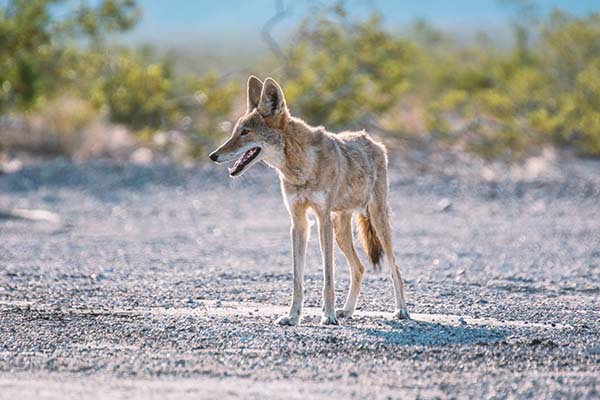It is not unusual to see a lone coyote in the wild. There are many reasons why this may want to happen, but it is typically because they are sick, injured, or young and now not yet capable of traveling with a pack. Coyotes also may be using themselves if they have been separated from their pack due to human intervention such as traveling.
Do Coyotes Have Packs
A pack is a group of associated coyotes who stay by using a hierarchy device to defend their family territory. The crew of coyotes can also be known as a band, however, is most typically called a pack.
As a member of the dog’s family, coyotes are pack or social animals. This capability that they do have packs and even interact as a pack. Unlike their wolf relatives, the coyote pack is smaller and usually only includes family members.
However, coyotes have been recognized to also be solitary animals, which means they journey and travel alone. These coyotes will regularly join a pack for a short quantity of time, during winter for instance, earlier than shifting on.
A coyote pack can vary greatly in size, depending on different factors similar to niche, food, and predators. The biggest factor that affects the pack’s size is the size of the nascence mates ’ waste. Coyotes have the capability to acclimate the size of their waste grounded on the vacuity of food in the area and the relative danger from predators.
Protected Habitat
A defended habitat is a home that the group of coyotes can well cover.
The benefit of a defended habitat is that the alpha mates don’t have to worry about predators. Food is also generally abundant because the pack controls the area.
In this habitat, the pack size is generally large, containing 5 to 6 adult coyotes as well as all the pups born at that time.
Unprotected Habitat
An unprotected habitat is generally set up in pastoral areas where stalking and trapping are relatively common. In this habitat, the pack size is relatively small, containing only the alpha pair and any pups born that year.
The pack is small in a vulnerable habitat because food is generally more scarce, and the alpha pair has to concentrate more on guarding their youthfulness against predators — both animal and human.
How Often Are Coyotes In Packs
An unprotected habitat is generally located in rural areas where searching and trapping are quite common.
In this habitat, the pack measurement is pretty small, containing only the alpha pair and any pups born that year.
The pack is small in an unprotected habitat due to the fact that fast food is generally more scarce, and the alpha pair has to focus more on protecting their young from predators—both animal and human.
Why Coyotes Travel In Packs
To Take Down Large Prey
One of the main reasons coyotes travel in packs is to take down large prey they else couldn’t take down on their own. But our howling canine can infrequently take down a healthy deer on its own. A typical western coyote weighs between 15 and 40 pounds, but the larger eastern runner weighs in at a normal of 35 to 55 pounds. This is allowed to affect cold-blooded breeding with wolves.
Nevertheless, taking down a completely grown adult deer is delicate for any coyote. To combat this, they gather the family together and go on a travel.

To Teach Their Young
Coyotes have their pups in early spring around March or April. Both the male and the female care for the young. In simply 35 days, the pups are weaned from the mother and venturing out of the den to explore their new world.
During the first six months of life, coyotes are constantly mastering their parents. They learn what is and isn’t OK to eat, how to behave, and how to travel. Before the pups attain six months of age, one or each of the dad and mom will take them out and teach them how to travel. While it would possibly not be as dramatic as chasing down a deer, the adult coyotes will teach them how to travel smaller prey like mice and squirrels.
For A Higher Success Rate
Coyotes are clever. It can not be denied. They’re one of the most adaptable animals on the planet, proven by their vast expansion across North America, Canada, and Central America.
One illustration of how coyotes are adaptable is their stalking behavior. While most predators are busy sticking to their normal routines, coyotes will travel alone, in pairs, or in a group to take down whatever occasion is available.
When coyotes aren’t feeling a family spin, they occasionally form loose pairs to go on a travel. While this isn’t inescapably considered ‘ pack ’ stalking, it’s still not lone traveling.
Traveling in pairs helps coyotes cover a larger area and increases their chance of success.
With Badgers
There are tons of examples of two different species working together to profit from each other. Bees and flowers, ants and aphids, clownfish, and anemones.
Occasionally, these partnerships involve more than one coyote. Reports from the National Elk Refuge in Wyoming have reported a badger working with two coyotes, forming a small stalking pack.
So, how does this peculiar cooperation work? It has not been proven that both parties profit. In some observations, the coyote would nip at the badger or steal its caught prey. Still, occasionally both the badger and the runner benefit.
Badgers are exceptionally good at digging, while coyotes have exceptional hail and smell. To get at ground squirrels, the coyote can identify where a squirrel is located and the badger can dig into the burrow to flush the animal out.
Similar to when coyotes work in pairs, working with badgers increases their success rate of catching small prey.



